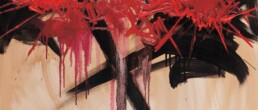Pierre Soulages
1919 (Rodez)- 2022 (Nîmes)
No work available for the moment.
Biography
Born in Rodez, Aveyron, in 1919, Soulages is also known as “the painter of black,” owing to his interest in the colour “both as a colour and a non–colour. When light is reflected on black, it transforms and transmutes it. It opens a mental field all its own.” He sees light as a work material; striations of the black surface of his paintings enable him to reflect light, allowing the black to come out of darkness and into brightness, thus becoming a luminous colour.
Before World War II, Soulages already had toured museums in Paris seeking his vocation and after wartime military service, he opened a studio in Paris, holding his first exhibition at the Salon des Indépendants in 1947. He also worked as a designer of stage sets. He is considered with Hans Hartung and Georges Mathieu, and Gérard Schenider, as one of the most important protagonists of the French Movement « Lyrical abstraction ». He participated in several exhibitions with Hartung and Schneider in the parisian galleries of the Abstract Avant-Garde, such as the Galerie Denise René or Lydia Conti, and knew André Marfaing, another abstract french painter interested by the contrast between darkness and light.
Soulages began to gain recognition in the United States in the 1950s. His works were included in the two major exhibitions of European artists, Younger European Painters at the Solomon R Guggenheim Museum (1953) and The New Decade: 22 European Painters and Sculptors at the Museum of Modern Art (1955) in New York. In 1979, Soulages was made a Foreign Honorary Member of the American Academy of Arts and Letters.
From 1987 to 1994, he produced 104 stained-glass windows for the Romanesque Abbey church Sainte-Foy in Conques (Aveyron, France). Soulages is the first living artist invited to exhibit at the state Hermitage Museum of St. Petersburg and later with the Tretyakov Gallery of Moscow (2001).
A composition he created in 1959 sold for 1,200,000 euros at Sotheby’s in 2006.
In 2007, the Musée Fabre of Montpellier devoted an entire room to Soulages, presenting a donation he made to the city. It included twenty paintings dating from 1951 to 2006, among which were major works from the 1960s, two large “plus-black” works from the 1970s, and several large polyptychs. A retrospective was held at the Centre National d’Art et de Culture Georges Pompidou from October 2009 to March 2010. In 2010, the Museum of the City of Mexico presented a retrospective of paintings that also included an interview-video with the artist (Spanish subtitles).
In 2014, Musée Soulages opened in Rodez, France, Soulages‘ hometown, as a place to permanently display his works and to house temporary contemporary exhibitions. Soulages donated five hundred works. The paintings represent all stages of his work, from post-war oils to a phase of work he calls Outrenoir. Soulages worked with dark, but also with blue, and brown. All the steps of his creation are represented in this permanent exhibition, as his collages.
It was the most complete display of work from his first 30 years. It was discovered that he has distant relatives that live in Arizona.
In 2014, Soulages presented fourteen recent works in his first American exhibition in 10 years, at Dominique Lévy and Galerie Perrotin, New York.
In September 2019, the Levy Gorvy Gallery in New York holds a major exhibition ahead of the retrospective at the Louvre Museum in December celebrating his 100th birthday.






